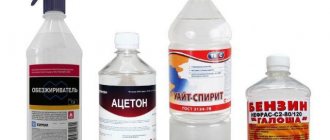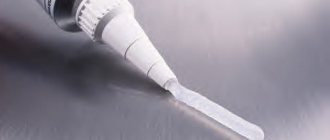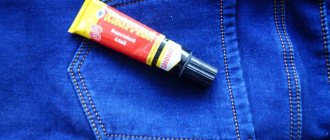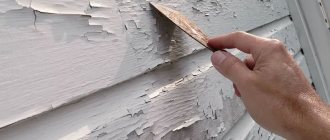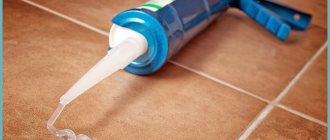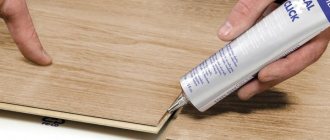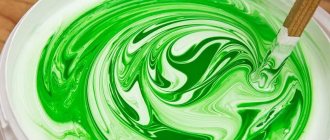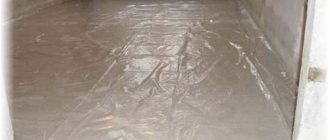Methods for removing silicone sealant
Removing fresh silicone sealant is not a problem. It can be washed off with a cleaner, solvent, or even a simple cloth soaked in water. But in cases where the contamination has already frozen, drastic measures will be required. In this case, you can use a mechanical, chemical method or a combination of both.
- Mechanical method.
This cleaning involves removing contamination using various tools. Most often applied to polyurethane sealants. Often the mixture is cleaned off with a blade, spatula, knife, or even an old bank card - that is, something hard and thin.
- A spatula is used very often for these purposes. The sharp edge easily picks up the sealant and cleans it off any surface. However, it is important to make sure that the edge is smooth, otherwise the tool will simply scratch the surface.
- The knife copes well with large amounts of silicone. It picks it up easily, quickly removes it, and the handle is comfortable, the small size of the tool allows you to reach the most hard-to-reach places.
- You can use a razor blade, but it can leave scratches and is not very convenient to work with.
- A bank card is an ideal option for small stains. It will not scratch the surface, easy to use. Most often it is used after treating the mixture with chemicals.
You can also use pumice, steel wool, or a stiff brush.
Removing silicone sealant mechanically
- Chemical method.
If there is a lot of silicone sealant spilled or a simple knife or spatula cannot clean it up, then you can use chemical solvents. This includes specialized products, which will be discussed below, as well as 70% vinegar, oxide, alcohol and amide preparations, gasoline, white spirit, acetone, solvent and similar solvents.
- Vinegar is often used as a silicone cleaner. Most often used on fabrics.
- White spirit softens silicone well. But it cannot be used on a painted surface.
- Acetone should always be tested on the most inconspicuous area. It is more aggressive than White Spirit and is never used on plastic. Apply it until it softens, when the mixture begins to lose its shape, and then wash it off.
- Kerosene and gasoline are highly effective products and can cope with cleaning as well as expensive solvents, but they have a persistent, unpleasant odor.
Removal from clothing and skin
The easiest way to remove fresh traces of silicone from clothing is before it is firmly absorbed into the fabric. You just need to stretch the material and remove the silicone film by picking up the edge with a sewing needle. If this fails, the item must be placed in the freezer for 2-3 hours, or even overnight. Repeat the procedure.
If the stain has already begun to eat into the fibers, the stained area can be soaked in a 70% solution of vinegar essence for 30 minutes, and then wipe off the sealant with a piece of rag. It is important to remember that when working with vinegar essence of such a concentration, you can be poisoned by its vapors, so you should use a respirator, gloves and safety glasses.
You can use alcohol to remove the silicone compound. Medical, denatured alcohol or regular vodka will do. Moisten the dirt generously with alcohol, let the fabric soak, and then remove the sealant with a brush. The substance will gradually separate from the fibers of the material and roll off. You can use hydrogen peroxide instead of alcohol.
To remove silicone sealant from clothing, use any organic solvent. Soak a foam sponge or cotton pad in the chosen product, wipe off the dirt, and leave for half an hour. After this, the item should be thoroughly washed by hand. If necessary, repeat the procedure.
Automatic washing will turn a fresh stain into an old one, making it much more difficult to remove. Since organic solvents can damage the structure of the fabric or change its color, it is worth testing their effect on a small area first. You can use the liquid in another way: apply it to the stain, cover it with paper and iron it.
If necessary, you can use simple methods to remove silicone sealant from the skin of your hands:
- Rub the plastic bag over the contaminated areas of the skin, collecting the sealant, and then wash your hands with soap. Fresh dirt can be removed with a piece of woolen cloth.
- Place your hand in tolerably hot water for a few minutes, soap the dirt and treat it with pumice.
- Soak a cotton pad in alcohol, nail polish remover, acetone or gasoline and remove any remaining sealant.
- Dilute table vinegar with water in a 1:1 ratio and wash your hands in the solution.
- Heat the vegetable oil, apply it to the dirt and treat with washing powder.
After removing the remaining silicone composition from the skin, it should be thoroughly washed with soap under running water and lubricated with a nourishing cream.
Specialized means
Also check out these articles
- Professional heating installation is the right decision
- Features of manufacturing products and containers made of polyethylene
- Perennial drip tube - an alternative to tape
- Features of choosing a staircase for a private house
On the market you can find a wide variety of specialized products for removing sealant residues. They come in the form of paste, aerosol, cream. The most popular ones are listed below.
- "Dow Corning OS-2" - suitable for removing silicone from plastic, ceramics, glass, metal. It must be applied for 10 minutes on average and then rinsed off with a sponge.
- Sili-Kill removes dirt from concrete, metal, glass and ceramics. It is usually kept for up to 30 minutes, which is quite enough.
- Quilosa Silicon Remover is a paste-like substance that is suitable for removing new or old silicone. The holding time for cleaning depends on how old the mixture is and can range from 1 to 24 hours.
- “Lugato Silicon Entferner” is a paste suitable for most different surfaces (glass, plastic, acrylic, tiles, enamel, stone, metal, concrete, wood, plaster). It is applied for about 1.5 hours and then removed.
- “Penta-840” is a sealant remover used on plastic, stone, glass, and concrete. You can also use it to treat tiles and cast iron bathtubs. However, it is important to test it on a small, inconspicuous area before using it. The duration of exposure to contamination is 30 minutes, so using a hard sponge, the mixture is removed.
Important!
Before using the solvent directly on the stain, you need to test it on some inconspicuous place. Such a test will allow you to understand whether the solvent is suitable for a given material and whether it will spoil it during the cleaning of silicone.
These chemical solvents are usually more effective than the simple mechanical method, but may be hazardous to the skin, eyes, or respiratory system. They must be handled carefully using gloves, a respirator and safety glasses!
Specialized silicone removers
We wash the sealant from the enamel bathtub and tiles
To remove old sealant from an enamel bathtub or tile, you need to pry it off and try to remove it with a solid tape. We will have to abandon the use of some mechanical cleaning methods and the use of coarse abrasives, the use of which leads to damage to the surface of the product. As an exception, you can use a sharp knife or thin blade to very carefully cut off the silicone layer without touching the surface of the bathtub or tile.
Remains of the sealant mixture can be removed using solvents such as acetone, kerosene or white spirit. You can also use vinegar. The selected product is applied to the previously cleaned surface for 2-3 hours until the silicone is completely softened, which is then removed with a spatula. If necessary, the solvent is left overnight.
If a low-quality sealant was used or it was applied in a thick layer, the sealant will have to be removed in several stages, gradually dissolving and removing it. Using a rag soaked in solvent, treat the enameled surface or tile until the remaining silicone begins to roll off. The pellets are easily removed with a dry cloth.
If the ceramic tile has a porous structure and is not covered with protective enamel, to remove residual sealant you will have to soak the surface with a solvent several times, gradually removing the remaining contamination with a scraper, plastic spatula, brush or even pumice stone. You can use a melamine sponge. Before using a solvent on a large surface, it is worth testing its effect on the tiles in a small area.
Traces of sealant after renovation in the bathroom must be removed as quickly as possible, before it finally adheres to the surface of the bathtub or tile. In this case, it will be possible to avoid the appearance of sloppy marks on the surface, which over time may darken due to adhering dust or dirt and completely ruin the appearance of the room.
Cleaning hands from silicone sealant
During work, silicone sealant often gets on your hands. What to do in this case? Most often it is cleaned with salt and pumice. First, salt is dissolved in water. They put a lot of it in - the solution must be concentrated. It is this liquid that you need to put your hands in and hold for about 5 minutes. After this, you can begin to slowly scrub off the dirt with a pumice stone.
If you get polyurethane sealant on your hands, it is very difficult to remove it using chemical or mechanical methods. The simplest thing is to wait until it gradually falls off over time. You can also try steaming your hands in a saline solution and using a pumice stone as mentioned above, but this usually does not help. To prevent this type of mixture from hardening on the skin during work, it is worth lubricating it with liquid silicone before work.
How to scrub with specialized compounds?
There are commercially available chemicals that allow you to quickly and safely remove the sealant from your bathtub. Top 3 effective compositions:
- HG cleaner is a product for removing silicone sealant. It can be applied to different types of surfaces. The composition is intended for use in rooms with high levels of humidity. The set includes a brush and spatula for comfortable and safe work. One package is enough to treat an area of 10-15 square meters. Price – 750 rubles.
- Silicone cleaner Tytan Professional . The paste is in a convenient cartridge and is squeezed out of the spout. It can be used for different types of surfaces, to clean fresh and hardened sealant. Price – 480 rubles.
- Silicone cleaner TKK APURSIL . The product can be used to remove sealant from bathtubs, showers, hoods, and tiles. It quickly and effectively dissolves not only silicone, but also polyurethane foam. Available in spray form. Price – 255 rubles.
How to remove silicone sealant from tiles?
We recommend reading our other articles
- Professional creation of layouts
- Selection of interior doors
- Why selling apartments in the Sofia residential complex is an advantageous offer, the advantages of living in this complex
- Advantages of modern stainless steel pipeline fittings
To remove all remaining mixture from the tiles, you must follow certain instructions.
- Protruding parts of the insulation, large accumulations, are cleaned off with a sharp spatula, knife or similar material - whatever is convenient for the job.
- Now you need to soak a rag well in a solvent (Penta-800, Silicon-Entferner are suitable) and apply it to the remaining dirt. The liquid should not drain. The longer it is absorbed, the better the effect will be.
- After 5-10 minutes, the solvent will take effect and you can wipe the silicone with a rough rag or a wooden spatula from the tiles. The unsightly stain that usually remains can be removed with a soap solution.
If sanitary sealant was used, it is removed a little differently.
- The top layer, as before, is scraped off with a sharp object.
- Apply gasoline, kerosene or solvent (one of the above or any similar) to the residues.
- Then take a steel wool and scrub off the dirt.
- The last thing left to do is to wipe the tiles with soapy water.
Mechanical removal methods
There are many ways to solve this problem, which have been tested by experts in real life. First, you should familiarize yourself with mechanical methods. In the process you will need: a knife, a blade, rags, an eraser.
The most popular method is removal with a razor or a regular blade. It must be sized to completely grip the sealant line and sharpened.
The blade is simply applied to the acrylic surface and guided in the direction of the sealant, thus cutting off excess material.
There is no need to worry about damage to the bathroom, since acrylic, like other materials, is quite resistant to mechanical damage. If scratches appear, they will be almost unnoticeable, but to reduce risks it is better to act cleanly and carefully, and most importantly, slowly .
The knife also acts like a blade, carefully cutting off the remaining material with its sharp part. The main thing is not to take an ordinary table knife, but to use a sharpened stationery or construction knife, since they are most suitable for this task. Residues can be easily removed with a simple eraser.
You should not try to simply peel off the sealant, as this method will lead to serious damage to the acrylic coating. It will simply come off along with the silicone.
How to remove sealant from plastic?
The sealant usually gets on the plastic when the gaps between the window and the window sill are sealed or when repairing the shower stall, plastic shelves, etc. Dirt in this case spoils the entire appearance of the surface, so it is recommended to clean it off. But how to remove silicone sealant from plastic?
Important!
Do not use acetone or solvent 647 to remove sealant from a varnished surface. Because the varnish itself can be cleaned off along with it.
Due to the poor adhesion of silicone to plastic, it is not difficult to remove such contamination. To do this, simply apply a little solvent (for example, Dow Corning OS-2) and wait from 10 minutes to an hour, depending on the type of product. The remains are wiped off with a simple rag.
How to clean plastic and glass surfaces
How to wipe off silicone sealant if it gets on plastic, be it a shower stall, pipe or other similar surface? Oddly enough, it is easier to remove frozen sealant from plastic than from other surfaces, since silicone does not stick well to it. Can be cleaned with a suitable solvent. Apply the product to the contaminated area and after about an hour, wipe off the softened silicone with a cloth.
How to remove sealant from glass? For mechanical cleaning, a thin, sharp blade is suitable. True, such work will take a lot of time, and the likelihood of damaging the glass surface is high. A solvent is best. More precisely, white spirit or gasoline are cheap and accessible means.
The algorithm is the same: wet the contaminated areas, wait about an hour and wipe off the dirt.
How to remove silicone sealant from glass?
Silicone sealant can be easily removed from glass using solvent, gasoline or kerosene. First, remove most of it with a blade - very carefully so as not to scratch the glass. After this, you need to moisten the residue with the selected chemical and wait 30 minutes. During this time, the cleaning substance will be absorbed and partially evaporated. All that remains is to wipe it with a sponge soaked in soapy water.
In addition, silicone is easily removed when heated to 300 degrees. In this case, it quickly softens and is easy to clean, especially from glass, mirrors or aluminum. The problem is that this is very difficult to achieve at home. The easiest option is to use a hair dryer, but even this is not always capable of creating such a temperature.
Procedure for removing sealant and applying new one
Several illustrative examples of removing old sealant and applying new ones will help you decide on the sequence of actions.
Example #1
Use a sharp tool or a special scraper to remove the old sealant. This must be done carefully so as not to scratch the sink, but at the same time deeply and thoroughly so that no traces of the old sealant remain. You can also remove old sealant using special chemicals.
Before applying new sealant, thoroughly clean the surface from dust and dirt. Degrease the surface with alcohol or White Spirit. After the surface is prepared for applying a new sealant, you need to decide what will be more effective and of better quality in your case. Apply the sealant immediately or first cover the application area with masking tape, colored tape or electrical tape. The main point is to provide a better and more even layer of sealant after pressing it in and removing excess.
You can evenly smooth the sealant with your finger, but a better quality seam is obtained if you use a special plastic spatula to apply the sealant. Special sets of spatulas for applying sealant are sold; they are also called spatulas for silicone. They differ in different thicknesses, edge angles and shapes, for better formation of the sealant seam.
By the way, it wouldn’t hurt to say that there are also special attachments on sale that fit directly onto the sealant tube and allow you to apply and level the sealant in one pass.
Nozzle for applying and leveling sealant
Example No. 2
What else would you like to read?
To the comment entry 8
Share a link to the article on social networks
You can leave a comment
Share your opinion, what do you think about what you read?
If you did not like the article, write the reason in the comments.
Perhaps you noticed an error or have questions, write about it.
Only by knowing your opinion will it be possible to improve and supplement the article.
How to remove silicone sealant from a bathtub?
Depending on the type of bathtub, the means and methods for removing silicone sealant may vary.
- Acrylic bathtubs are cleaned with specialized solvents. The selected product is applied to the stain, left for a day, and only then can it be cleaned off with a wooden spatula. Then the surface is wiped with alcohol.
Important!
To clean an acrylic bathtub, do not use abrasive, organic substances or sharp objects that can scratch the surface.
- You can remove the frozen mixture from steel and mechanical baths using both mechanical and chemical methods, but in order not to damage the top layer of enamel, you should handle them carefully. The topmost layer is cut off with a spatula, and the remains are wiped off with sandpaper, pumice or similar material. After removing the silicone, a stain usually remains; remove it with a sponge and clothes washing powder. If the contamination is old, then you can use solvents: gasoline, acetone or something similar. The silicone will soften for some time, and then the resulting mass is simply wiped off the bathtub. The remaining greasy stain can be removed with baking soda and washed with soapy water.
Cleaning the bathtub from residual sealant
How to remove acrylic sealant
Acrylic sealants can be water-soluble or water-resistant. But their main function is not sealing, but gluing. Compositions for interior work are porous and, as a rule, water-soluble. Therefore, in the bathroom their use is limited to places where water does not get in (you can glue various hooks, mirrors or shelves).
Waterproof acrylic sealants are designed for exterior finishing and construction work. In general, they are universal and after complete drying they are not afraid of moisture, but constant contact with water has a bad effect on their properties. Waterproof acrylic glue is sometimes used to install borders (or baseboards) for bathtubs and washbasins, which is not entirely correct.
Removing acrylic sealant is much easier than silicone:
- excess fresh glue can be easily wiped off with a sponge or rag moistened with water;
- the old dried composition is cut out with a stationery knife or blade;
- water-soluble acrylic is moistened with water until softened;
- Waterproof acrylic sealant can be removed from the edges of an acrylic bathtub with mounting foam, acetone, nail polish remover or a solvent such as white spirit;
- the remaining composition is removed with a wooden scraper or plastic window cleaner;
- Acrylic sealants do not leave greasy marks or stains after removal, so additional treatment with solvents is not required.
Folk remedies for removing sealant
Folk remedies for removing sealant from a bathtub can also be effective. The still wet layer of the substance is simply removed with a wool cloth or a rubber scraper. But hardened material requires more drastic measures.
Traditional methods involve not only the use of sharp objects, but also the creation of solutions using improvised products. And often this is the best option; there is not always a desire to use harmful chemical compounds.
The still wet layer of the substance is simply removed with a wool cloth or a rubber scraper.
Regular table salt or soda
Regular salt, which is found in every home, will help you cope with the task. Salt is poured onto a sponge, and the coating is vigorously scrubbed with it. The wet state of the salt is important in this method. This technique is effective for thin layers or for small areas; large areas cannot be eliminated. But salt can deal with small stains quickly.
Soda is used in the same way; the cleaning process is the same as working with salt. The cost of such methods is minimal, and the presence of products in the house allows you to cope with the task at any time.
The wet state of the salt is important in this method.
How to replace sealant
First of all, it is important to choose an original product from a trusted manufacturer. Bathroom compositions must contain a biocide (antimicrobial component). It is advisable to purchase sanitary silicone sealant in specialized stores: as a rule, storage conditions are observed there and there is less chance of buying a fake.
Technology for applying a new layer of sealant:
- The working surface is degreased with any available means and dried thoroughly.
- To prevent unwanted contact of sealant with surrounding areas, the area around the work area can be covered with masking tape.
- The tube with sealant is prepared for use according to the instructions.
- Carefully apply the composition.
- Form a seam around the entire perimeter of the application, removing any remaining sealant. To obtain an even, uniform seam without defects, it is better to use not your finger, but a spatula, a ruler or an old payment card.
- Before use, wait until the sealant has completely dried (12 to 24 hours).
Note: Sealant should not be applied to wet surfaces. Even if the silicone adheres to the base, mold is guaranteed to begin to grow underneath it.
In practice, even high-quality formulations with antifungal additives can be affected by mold. This is possible in a number of cases:
- violation of sealant application technology;
- purchasing a counterfeit;
- favorable conditions for the development of fungus (high humidity, poor ventilation).
If every time a fresh sealant quickly becomes covered with mold, you should eliminate the listed reasons one by one (purchase the product from another store or from another manufacturer, check the humidity in the bathroom).
Advice! If you need bathroom renovation specialists, there is a very convenient service for selecting specialists from PROFI.RU. Just fill out the order details, the experts will respond and you can choose who to collaborate with. Each specialist in the system has a rating, reviews and examples of work, which will help with the choice. Looks like a mini tender. Placing an application is FREE and does not oblige you to anything. Works in almost all cities of Russia.
If you are a master, follow this link, register in the system and be able to accept orders.
Types of silicone-based sealants
Before you begin removing such material, you need to find out its qualitative composition. Sealants come in one- and two-component types. The former are used in everyday life and construction, while the latter are used for industrial purposes.
Classification of sealants:
- Alkaline sealants are special purpose sealants. They are made on the basis of amines.
- Acidic - they are based on acetic acid. A specific odor occurs during the hardening process of the material. They are universal in application and have low cost. They are usually marked with the letter “A”. Acidic sealants are incompatible with materials based on marble and cement containing alkali. In addition, they accelerate the process of corrosion of most non-ferrous metals, which makes their combined use impossible.
- Neutral - produced on the basis of ketoxime and alcohol. This material is used for joining various surfaces.
Removing silicone from tiles
To begin, cut off as much of the remaining sealant as possible from the tiles. This must be done very carefully so as not to damage the tile. Then rub white spirit/gasoline into the remaining silicone with a rag. This will soften the sealant, it should look like jelly and will be easier to remove.
Do not use products with abrasive ingredients, as they will scratch the surface of the tile.
Another option is to rub kerosene into the sealant. This flammable mixture also softens it. You can also rub detergent into the remaining silicone. But using them will only delay the cleaning process.
Cleaning tiles
It happens that the silicone does not come off as a whole strip. The reason for this may be an incorrectly selected cleaning agent, or you may have received a second-rate sealant. In such a situation, the process of rubbing one of the above liquids must be repeated. Alone doesn't help? Try another one. As a result, the sealant should begin to roll off. The easiest way to remove the formed pellets is with a dry cloth.
But what if you need to remove the remaining sealant from tiles that have a porous base? Well, in this case you will have to work harder. In this case, the adhesion of the tiles to the silicone is stronger. Apply solvent to the remaining silicone alternately. You can remove it with a pumice stone/scraper.
Before using any solvent, test the tile's reaction to it on a small area. Otherwise, you may damage the finishing material. This point is especially important to consider when it comes to painted parts.
How not to spoil the surface
- Cleaning the base with a blade or knife is carried out very carefully to reduce injuries and damage to the surfaces being treated.
- It is better to remove a thin layer of sealant on acrylic bases with an eraser, damp pumice, fine sandpaper or soft wood chips.
- If the silicone is very hardened and cannot be treated by any mechanical means, it is first softened with chemical compounds.
- Do not try to tear off the sealant by force; in some areas it may separate along with the top layer of the bathtub or the tile covering.
- When choosing a thinner, you need to pay attention to the components of the sealant, especially if acrylic is being cleaned. The packaging of the product must contain a list of materials allowed for processing.
How to dissolve silicate: we use special chemicals
The modern construction industry has long figured out how to wash silicone sealant from hands and other surfaces. Go to the hardware store. Among the variety of solvents that will help remove special glue, the following have proven themselves well:
- mixture 646. Apply within 20 hours after application. Transforms the composition into pellets. They can be easily removed with a dry cloth;
- Quilosa Limpiador. Can also be used after 24 hours from applying the silicone. Cannot be used on leather furniture;
- Sili-kill. Effective and safe for any surfaces;
- Silicone Remover. Capable of removing silicone from non-porous surfaces. Not suitable, for example, for decorative stone;
- Removes special glue from rubber. Well known to car owners;
- "Penta-840". Domestic product. Suitable for all types of surfaces;
- Toxic, but very effective.
These are the most active solvents, tested by numerous users, that can quickly and completely wash off the composition.
Important: before use, conduct a mini-test on a small area of the surface hidden from prying eyes. If the material has shrunk and the paint has peeled off, then it is not advisable to use such a product.
Observe precautions when working with solvents – caustic and toxic. Possible chemical burns and vapor poisoning if inhaled. Wear a protective mask, gloves and goggles before washing off silicone.
Shield glasses will provide reliable face protection from silicone sealant solvents. If the solution suddenly splashes, you don’t have to worry about the skin of your face and eyes
The nuances of cleaning tiles
The sealant can be removed from the tiles using the same compounds as for the bathtub . Preference should be given to chemicals that do not contain aggressive components. Gasoline, alcohol and vinegar cope well with this task.
A thin layer of sealant can be removed with a paper eraser or pumice stone. A school rubber band is especially helpful when the tiles have a corrugated surface.
It is not recommended to use metal tools. They can cause chips and scratches on the tile surface.
You can learn more about how to remove silicone sealant from tiles in this article.
